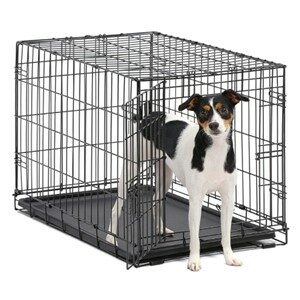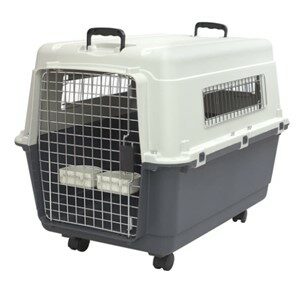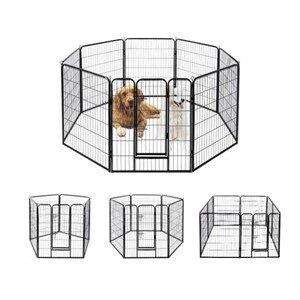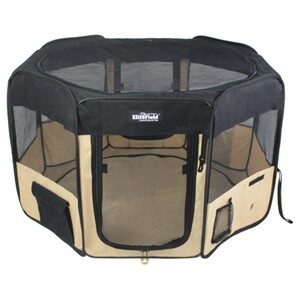Are Crates Bad For Dogs
Use A Crate For Housetraining Dogs
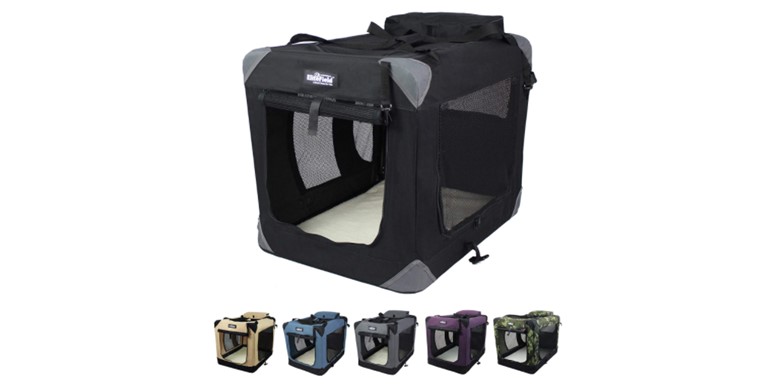
Are crates bad for dogs as some pet owners may be asking themselves? The short answer to this question is no. It depends how you are going to use the crate with your dog. When you bring your pet home for the first time, he does not know all the rules. You will have to teach him what he can do and where he can go.
A crate will restrict his movements around the house or apartment. As he learns what he can and cannot do, like no accidents, and disruptive behaviors, he can be rewarded by going into other rooms.
When your dog goes into other rooms, you may want him on a leash to allow him to explore while under your supervision. This will keep him out of trouble.
You can shop for crates by clicking here!
Video – Crate Training Your Puppy
When you bring home your new puppy, it is very important that you begin his crate training. Below is an excellent video on how to do this. Take a look!
Introduction
Dog crates can be used for keeping a pet safe while the owner is busy doing chores and cannot observe them. They are also great allowing pets to rest and sleep. You can use them to potty train your dog. The purpose of this article is to provide information about crates for new dog owners. We agree that crate training is time consuming, but in the end, it’s worth it. So, take the time to learn how to crate train your dog.
There is a warning here that when you bring home your furry friend do not force him into the crate. This can be detrimental to his acceptance of the crate and create a bad experience in his crate training. It will make it difficult for you as well. This is what you want to avoid.
Your objective is to begin some kind of crate training routine.
Puppy Crate Training Schedule
- 7:00 a.m. – Try to get up before your puppy and softly call his name to get him out of the crate before taking him outside to relieve himself.
- 7:10 – Whenever he’s done, play around a little bit.
- 7:20 – Feed and water him inside, generally in the kitchen, giving him some fifteen to twenty minutes to eat before taking the bowl away.
- 7:45 – Take him outside to relieve himself once more.
- 8:00 – Go about your normal routine. If you crate your pup while at work, continue doing so.
- 12:00 – If you left him in the crate, someone needs to take him out again. Though grown dogs don’t like to make a mess in the areas they sleep and eat, a puppy has limited control over his bowels and bladder.
- 12:15 – From here, it’s merely repeating the morning’s routine. Play. Food. Water. Re-relief. When you’re home in the evening, it’s still important to find intervals to crate him, if for only thirty minutes at a time. Again, the faster he get’s used to his Gunner Kennel, the faster he’ll treat it as a source of comfort.
As he grows older and starts traveling more, you’ll be able to leave your dog in the crate for longer periods of time.
Begin A Crate Training Routine
When you crate train your dog, you are taking advantage of his natural instinct to seek a safe and quiet place when the environment around him gets overwhelming. This is an excellent tool in preventing your dog chewing on items you don’t want to chew on and during his house training sessions.
The main purpose of a crate is for housetraining. When dogs are in their crate they will not soil their sleeping place. Crates limit access to the rest of the house. During this training they will learn rules not to chew on furniture or have accidents. Crates provide a safe way to transport your dog in the car going to the vet, vacation, or store and doing house chores.
When you begin the crate training routine, stick to it. It may be difficult at first for both of you. In the end, it will be worth it.
Puppy potty training schedule: Take the puppies age in months equals how long he can hold his bladder. Example, 2 months between 2-3 hours. For every additional month, add 1 hour. Puppies 6 months and beyond, 6-8 hours.
Types of Crates
As you decide on using a crate for your dog, be aware that there are different types of crates. We mention them so you can decide on which type is best for your situation.
There are 3 types and they are:
- Plastic
- Metal
- Soft Sided
Plastic
Plastic crates are generally used for transporting your dog in the car or on an airplane. They hold up nicely because they are sturdy and offer many years of use. These crates are easy to clean or hose down and durable.
Some of the cons of these crates are: they do not fold which makes them difficult to store. Plastic absorbs odors and can leave a permanent smell. They can be difficult to carry around.
Metal
These are the most common crate that most dog owners use. The crates are well-ventilated and easy for owners to see their pets and dogs to see their owners. Great for dogs that like to chew. These crates provide air-flow and most can be folded for storage. The metal does not absorb odors and will be odor-free and is easy to clean.
Some of the cons of these crates are: they are expensive, dog hair can get stuck on the metal bars, and can be heavy which will be hard to move.
Soft Sided
The soft sided crates usually are made with soft mesh material. Some crates may have a steel tube frame, while others may look like a backpack or carrying case. The soft sided crates are very popular with dog owners. They are inexpensive, lightweight and easy to carry. They can be used for airplane and car rides.
The downside to these crates is they are soft and not durable. They are also the hardest to clean of all the types. These crates are not suited for dogs that are not crate or potty trained.
Crate Training Step By Step
This section will act as a guide on how to train your dog using a crate. Before you get started, be sure to have some of his favorite treats on hand so you can reward your pet when he performs the proper actions. You can view the video above to assist you in crate training your dog.
When you begin to embark on crate training, the most important step is to make it a positive experience for your dog. Try to make their crate time like a reward by feeding them their meals and treats in the crate.
Do not leave your dog in the crate all day. You need to limit the time based on how long they spend in their crate daily, their age, and level of house training.
By following the steps below, you will discover the amount of time your dog will be able to spend in his crate.
Step 1. Introduce Crate To Pet
When introducing a crate to your pet, place the crate in an area of the house where you or family spend a lot of time, like the kitchen or family room. Remove the door and see if your pet will explore the crate at his leisure. Some dogs will naturally do this. However, if your does not, do the following:
- Bring them to the crate and talk to your dog in a happy voice. Be sure to secure the door so it won’t hit your dog and frighten him.
- Encourage your pet to enter the crate by dropping some of his favorite food treats near the door. Then, a treat just inside the door. Last, toss the treat all the way inside the crate. If you’re pet goes in, great. If not, that’s OK. Just don’t force them to enter.
- Continue to toss treats in the crate until your dog walks calmly in the crate to get the food. This step is the most difficult and it may take a few minutes to a few days. Just don’t give up. You pet will eventually come around by going into the crate.
Step 2: Feed His Meals In The Crate
After your pet has accepted the crate, begin to feed his meals near the crate. What you are doing here is to associate a pleasant experience with the crate. Below are some additional tips.
- If you dog is entering the crate at the beginning of step 2, place the food dish all the way to the back of the crate.
- If they are reluctant to enter, place the dish as far inside as they are willing to go. Not being fearful or anxious. Every time you feed them, place the dish a little further back in the crate until you can place it all the way to the back of the crate.
- Once your dog is eating his food, and standing comfortably in the crate, you can close the door. When they have finished eating their meal, open the door. On each successive feeding, try leaving the door closed a few minutes longer, until they are staying in the crate for 10 minutes or more after eating.
- Some dogs may whine to be let out. If this is the case, the time was increased faster than they could accept. Next time, shorten the time period. If they should whine or cry in the crate, don’t let them out. They must stop first. Otherwise, they will learn that whining will get them out of the crate and will keep on doing it.
Step 3: Practice Longer Crating Times
When your dog is eating their meals in the crate with no signs of fear or anxiety, you can leave them in the crate for short periods of time when you are at home. This is good especially when doing chores or cooking the family meals.
Below are some helpful training tips:
- Call them to the crate and give them a treat.
- Give them a command to enter, such as “crate.” Now, encourage your pet by pointing to the inside of the crate with a treat in your hand.
- After your dog enters the crate, give them praise (“good dog” or “good crate”) and the treat and close the door.
- Sit close to the crate for 5 to 10 minutes and then go into another room for a few minutes. Then, return and sit quietly again for a short time and let your dog out.
- Now, repeat this process several times during the day. Then, gradually increase the length of time you leave them in the crate and the length of time you are out of sight.
- When your dog will stay quiet in the crate for 30 minutes with you out of sight, you can begin leaving them in their when you are gone for short periods of time. You also can let them sleep there at night. This will take days or several weeks. So, be patient.
Step 4: Crate Your Dog When You Leave
When your dog is spending 30 minutes in the crate without becoming afraid or anxious, you can start leaving them in the crate for short periods when you leave the house. Below are some helpful tips:
- Place them in the crate using the regular command and a treat. Also, leave some of their favorite toys in the crate.
- You will need to vary the “getting ready to leave” routine by placing your dog in his crate. Try to limit the time to crate him before you leave. A good reference is anywhere from 5 to 20 minutes before leaving.
- When you leave, don’t make the departures emotional and prolonged. Praise your dog briefly, give them a treat for entering the crate and leave quietly.
On your return home, your dog will be excited. Do not reward your dog for his excited behavior by responding to them in an enthusiastic way. Your objective is to keep arrivals low-key avoiding their increased anxiety on your return. Continue crating your dog when you are home for short periods from time to time. This is so they don’t associate the crating with being left alone.
Step 5: Crating Your Dog At Night
This step will be a little more challenging, so be patient.
Place your dog in the crate using the regular command and a treat. We recommend to put the crate in your bedroom or nearby in the hallway, for puppies. Puppies will need to eliminate during the night and you will want to hear when your puppy whines to be let outside. For older dogs, place the crate nearby so they don’t associate the crate with social isolation.
When your dog is sleeping comfortably through the night with the crate near you, gradually begin to move it to the location you prefer.
Dog Crate Caution
A crate is a great tool in housetraining and potty training your pet. However, if it’s not used correctly, your dog can feel trapped and frustrated. Below are some tips to help you.
- Never use the crate as a tool for punishment. Your dog will fear it and refuse to enter.
- Never leave your dog in the crate too long. A dog needs his exercise and human interaction and could become depressed or anxious if he doesn’t get sufficient exercise. Be prepared to change your schedule to reduce the amount of time your dog spends in the crate each day.
- If you have a puppy that is under 6 months of age they should not be crated for more than 3 or 4 hours at a time. They cannot control their bladders or bowels that long. The same is true for adult that are being housetrained.
- Crate your dog until they are able to be alone in the house without accidents or showing destructive habits. You can reward your dog access to an enclosed area like the kitchen. Then access to the entire house when you are away. The crate should have a comfortable bed and the door left open when you are home so your dog can enter it as his leisure whenever they need a safe space.
Remember, a crate may be your dog’s den, but he should not spend most of his time in the crate. Don’t forget his exercises and regular bathroom breaks.
Potential Crate Issues
Owning a crate is a good thing, but your pet may show some resistance to it. You need to be alert for whining and separation anxiety. We will explore these issues below.
Whining
You may encounter this issue on the very first day of introducing the crate to your pet. If your dog whines or cries while in the crate at night, it may be difficult to decide whether they’re whining to be let out of the crate, or whether they need to be let outside to do their business.
If you’ve followed the training procedures outlined above, then your dog hasn’t been rewarded for whining in the past by being released from their crate. If that is the case, try to ignore the whining. If your dog is just testing you, they’ll probably stop whining soon. Yelling at them or pounding on the crate will only make things worse.
If the whining continues after you’ve ignored them for several minutes, use the phrase they associate with going outside to do their business. If they respond and become excited, take them outside. This should be a trip with a purpose, not play time.
However, if you’re convinced that your dog doesn’t need to eliminate, the best response is to ignore them until they stop whining. Don’t give in; if you do, you’ll teach your dog to whine loud and long to get what they want. If you’ve progressed gradually through the training steps and haven’t done too much too fast, you’ll be less likely to encounter this problem. If the problem becomes unmanageable, you may need to start the crate training process over again.
Separation Anxiety
Do not use the crate as a remedy for separation anxiety as it will not resolve the issue. The crate may prevent your dog from being destructive, they may get injured in attempting to escape. Separation anxiety issues can only be resolved with counter conditioning and desensitization training procedures. You need to consult your vet who can recommend an animal-behavior specialist to assist you in resolving this issue.
Crate Training Makes Life Easier
You may be asking how crate training can make my life easier. Let’s mention a couple of tips.
- For pets that are not crate trained, they may be the scariest part of a harried situation. Crate training can help prevent a dog’s stress during emergencies. In some instances, dogs may be required to be on crate rest when recovering from surgery. A crate trained dog following surgery can peacefully relax that then aggravate injuries because they can’t settle down in a crate.
- Crate training will come in handy for dogs that might need a break from a bustling household and need a familiar place to rest. Crates help dogs to self soothe and deal with issues like anxiety during situations where they become distressed. During fireworks, thunderstorms, or construction. Dogs can retreat to their crates when things get too chaotic or scary. The same is true when a baby is added to the family or having company over.
- Crates makes it easier for safety when transporting your dog during long-distances, visits to the vet and shopping. They can lay down and rest without disrupting the driver. It’s a win-win for everyone. One final point, airlines require pets to fly in crates.
Conclusion
We presented lots of information for you to digest if a crate is useful for you and your dog. Crates and playpens are excellent tools to use as your puppy develops into an adult dog. Also, it will help you when you have to do chores, cook the meals and shop. Crates and playpens are also good for adult dogs when bringing them into your home for the first time. They also must learn your house rules.
Crates are helpful when you have company over, during thunderstorms, and fireworks. Crates allow pets to go into them at their leisure and knowing it’s their safe place to go.
We presented that crates must be used if you want your pet to fly with you. So, by beginning a regular crate training routine will be a win-win situation for everyone.
Happy crate training!
Go back to the Dog Luxury Beds home page.
